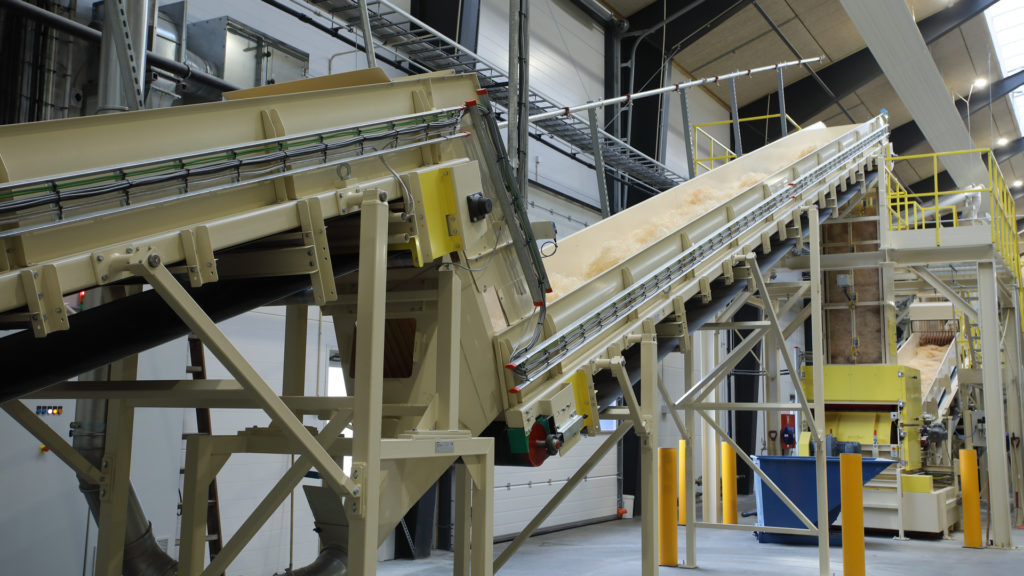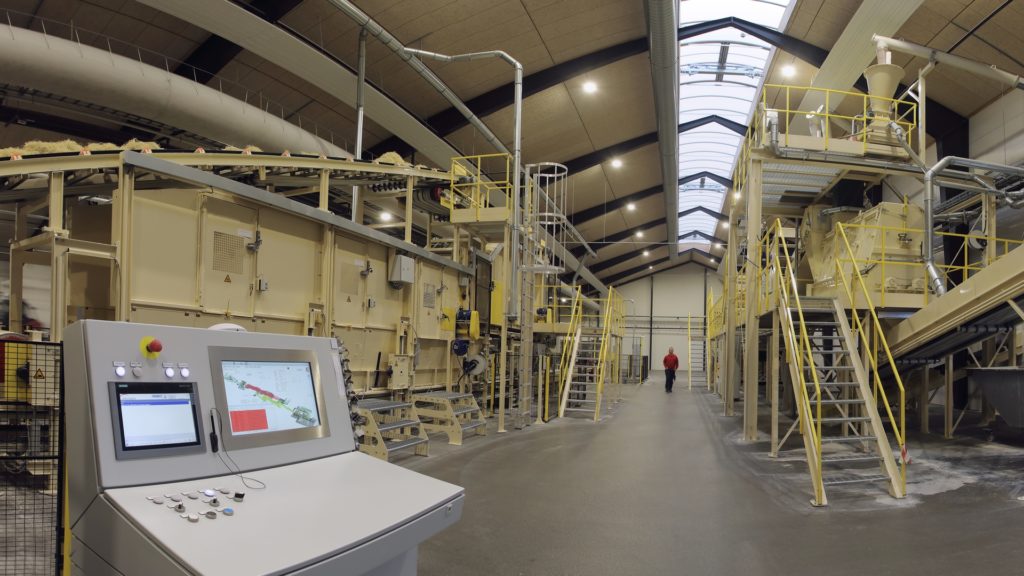The data below provides information on the two most common WWCB plant types as provided by Eltomation, which are:
A. Fully Automated WWCB Plant (incl. full Finishing Line).
B. Expandable (semi-automated) WWCB Plant.
Both Plant types are provided with the ELTOMATIC CVS-16 Rotating Wood Wool Machine, which allows the production of high-quality boards at high capacity.
The Fully Automated WWCB Plant allows for the production of the full range of WWCB products, which includes standard WWCB, (spray-painted) acoustic ceiling panels (usually made with white cement), Composite WWCB (with a core of EPS, XPS or Rockwool) and Reinforced WWC Roofing Boards.
- Standard WWCB (typically produced with grey cement)
- Acoustic ceiling panels (usually produced with fine fibers, white cement and optionally spray-painted)
- Composite WWCB (2- or 3-layer Sandwich board with a core of EPS, XPS or Rockwool)
- Reinforced WWC Roofing Boards (for high load bearing applications).
This advanced Production Line is provided with an “Automatic Board Drying Line, followed by a full “Finishing Line”, which includes operations such as Thickness Calibration, Trimming & Profiling and Spray Painting. Finished boards are automatically palletized, strapped and/or fully packed.
Optional to such “Fully Automated WWCB Plant” we can provide our Clients with a so-called “Expandable WWCB Plant“. Such Expandable Plant includes the main production line, however does not have the Board Drying Line and only a limited Finishing Line. To reduce the initial investment, the Expandable WWCB Plant is designed for the manual feeding of wood blocks and manual (de)stacking of boards. At a later stage, more equipment can be added, to increase the product range and reduce the labour requirements. This line is therefore more suitable for clients, where labour costs are low to modest and the market for the board still needs to be developed.
Eltomation will closely work with each Client to offer the best suitable “custom made” WWCB plant configuration in view of grade of automation, layout and labour requirements.


For more pictures of the WWCB Plant, click here.
Board dimensions:
The following board dimensions apply:
| Length: | 2000 / 2400 / 2440 mm (8′), when so required up to 3050 mm (10′) |
| Width: | 600 / 610 mm (2′) |
| Thickness: | 15 – 100 mm for solid WWCB |
| up to 150 mm for Composite WWCB) |
Board densities:
The max. density of dry WWCB ranges, in accordance with European Norm EN 13168 (formerly DIN 1101), from approx. 360 up to 570 kg/m³. Other densities may apply, subject to Client’s requirements and applications.
Plant capacities:
Table A: Plant capacity for WWCB
Fully Automated WWCB Plant and Expandable WWCB Plant, per each 1-shift operation (7 hours net production per shift).
Board dimensions of 2400 x 600 mm
| Board thickness in mm | m² per 1 shift (finished boards) | m³ per 1 shift (finished boards) | No. of boards per each shift |
|---|---|---|---|
| 15 | 4.110 | 60 | 2.855 |
| 25 | 4.110 | 105 | 2.855 |
| 35 | 3.905 | 135 | 2.710 |
| 50 | 2.905 | 145 | 2.015 |
| 75 | 2.010 | 150 | 1.395 |
| 100 | 1.580 | 160 | 1.095 |
Raw material consumption:
The raw material Wood for WWCB production consists of small-diameter soft wood, such as Pine, Spruce or Poplar. For example wood from forest thinning is suitable. Cement is common OPC (Portland Cement, such as CEM I 52,5 R). In addition Water and a Salt Solution such as Sodium Silicate (“Waterglass”) is used.
Raw material consumption, based on 1-shift production for boards of 2400 x 600 mm, 50 mm thickness are approx. as follows:
| Wood wool: | 20 ton |
| Cement: | 34 ton |
| Water: | 22 m³ |
| Salt solution: | 1,4 ton |
Labor requirements:
The following labor requirements apply, including labor for maintenance, warehousing, cleaning, etc.
Number of personnel per shift
Fully Automated WWCB Plant: 18-22
Expandable WWCB Plant: 22-26
Plant management is to the discretion of Client.
Power consumption:
Based on a full production capacity, the total installed electrical power and electrical power consumption (incl. dust extraction, compressor, etc.) are approx.:
Installed Electrical Power
Fully Automated WWCB Plant: approx. 2000 kVA
Expandable WWCB Plant: approx. 900 kVA
Electrical Power Consumption
Fully Automated WWCB Plant: approx. 1500 kW
Expandable WWCB Plant: approx. 650 kW
The Board Dryer in the Fully Automated WWCB Plant is gas (or steam) heated. Alternatively, the dryer may be heated by means of waste wood from the plant operation (such as the dust extraction system and bark).
Building and land requirements:
The size of the building for the Fully Automated WWCB Plant ranges from approx. 12.100 m² (e.g. 56 x 216 m), with an overall clear height of min. 5-6 meters (partly 7 meter clearance above selective equipment).
The size of the building for an Expandable WWCB Plant is approx.7.600 m² (e.g. 56 x 135 m), with an overall clear height of min. 5-6 meters (partly 7 meter clearance above selective equipment).
This floor space includes for intermediate storage space for curing of the boards, as well as the board trimming operation. Additional storage space may be required for finished products, subject to local conditions.
The minimum land area required, including log yard, is approx. 3-5 HA.
Budget Pricing:
The budget pricing for the Eltomation Equipment for the Fully Automated WWCB Plant and Expandable WWCB Plant are as follows:
Fully Automated WWCB Plant
Main production line, including Board Drying & Finishing Operations: EUR 15 – 18 Million
Expandable WWCB Plant
Main production line (incl. semi-automated small Finishing Line): EUR 8 – 9 Million
(Final pricing is subjected to agreed scope of supply)
These prices include engineering, project management, an estimate for DAP shipping costs and Installation Supervision and Commissioning charges. A detailed list of the items supplied by Eltomation is provided in our detailed System Proposal, which will be provided upon request.
Local supplied items (such as fork lift trucks, cement silo’s, waste/dust recovery system, etc.) are not included in the Eltomation Price. It will be possible to have additional selective parts of the plant equipment be sourced or manufactured locally per our specifications, which will reduce the above mentioned price for the equipment and shipping charges. These items could include certain conveyors, steel structures, etc. We are open for such discussion.
to download the Flow chart of WWCB production plant click here.